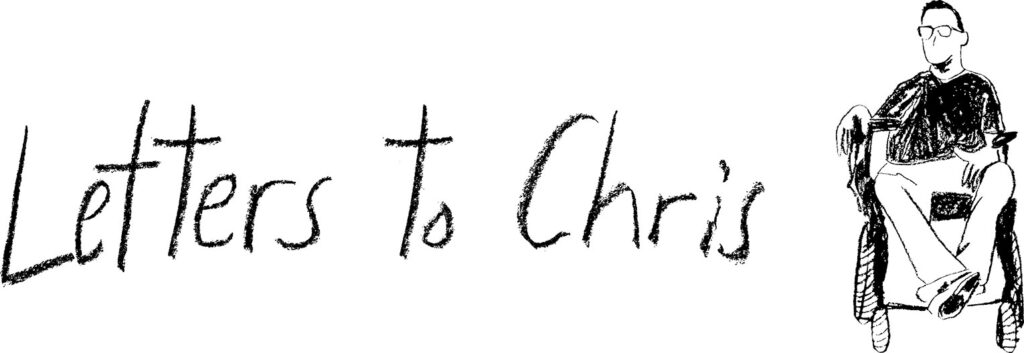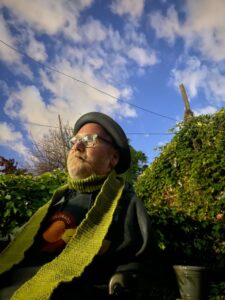DisArt mourns the loss and celebrates the legacy of our cofounder, Christopher Smit, (48), who passed away on January 4, 2022. Our friend and colleague spent his life, and his career, crossing the intersections of art, culture, and disability. Previously an associate professor of communication arts and science at Calvin College in Grand Rapids, Michigan, Smit co-founded DisArt with co-director Jill Vyn in 2014.
Born with spinal muscular atrophy, a form of muscular dystrophy, Smit’s experience as a disabled person informed his world view and his chosen career. “As a person living with a body that didn’t quite fit into the cultural categories of normality, I have always had a keen interest in the way that difference is experienced and communicated,” Smit once said. He felt art was a natural vehicle for discussions about being different, and that embracing what others have been conditioned to reject offered him and others “a rich terrain to investigate, critique, and celebrate the experience of … disability.”
With DisArt, Chris and Jill sought to share and expand this celebration. To provide others with a safe, shared space to challenge their own ideas and experiences. And to connect with others who are excited and inclined to do the same.
Chris’ life was all about investigating, critiquing and celebrating connections that foster positive changes in people, and by extension, in society. In death, as in life, he led by example. Since entering hospice last Fall, Chris approached his passing in similar ways. Rather than retreat, or isolate, he made reconnecting with friends and family a priority. In his final weeks of life, Chris was surrounded by those he loved, and those who loved him.
Rae Weekes Chris Smit. The man. We didn't know each other very well or for very long, but he clearly made an impact. There was an immediate ease in comfort when speaking with Chris that made him feel both impressive and familiar at the same time. His vision and drive were apparent in thinking outside the box and including everyone at the table. We are excited to see DisArt grow in his legacy under the astounding example that he set in his time there. Thank you. Just thank you, dude.
Marin Hann The truth is that Chris and DisArt have meant so much to me and been such a safe place. The community that DisArt brings together is a beautiful community - disability pride at its finest.
I don’t like thinking about Chris not being here in this world anymore. I don’t like being separated from him. I don’t like that more people in the world don’t get to know him. I wish we were all together still. I believe I will see him again, but it’s just not soon enough.
Sherry Rennick I met Chris while on site at an Artprize 2016 installation on Rumsey St. in Grand Rapids, Michigan. The exhibit, HYBRID STRUCTURES, was a collaboration with DisArt, Alois Kronschlaeger, Paul Amenta, and Ted Lott of Lott3Metz. Chris was there with other members of the disabled community and a large group of school children who were experiencing the interactive installation.
I was using a device that enabled me to capture the installation in 3D to produce a virtual tour of the structures so that online viewers could experience the space, virtually. Chris was curious about what I was doing, and after a brief discussion regarding the technology and the created deliverables, we exchanged contact information and agreed another meeting should be planned. I went back to working on the project, watching the children walk and run across the series of beautifully constructed ramps that connected various structures, "providing an accessible and inclusive exploration of the site. New vantage points were created into the abandoned buildings as well as the surrounding site, granting visitors an opportunity to experience Rumsey Street in new and extraordinary ways. Access became art".
I was forever changed in how I looked at ramps and other forms of accessibility. HYBRID STRUCTURES was a microcosm of what a world FULL of buildings, created with ease of access, means to those using wheels and walking supports. No barriers! Entry for everyone!
The experience with Chris that day forever changed my approach to my work. Subsequent collaborations with Chris and Jill has not only brought meaning to the work I do, but has certainly impacted my personal growth and ability to see perspectives I would not have been privileged to experience otherwise.
Erin OConnor Chris was first my professor, then my mentor, and finally my friend. In my first class at my new college way back in 2002, there he was first thing in the morning cracking jokes and leading us with his voice. Now, I cannot think of the word hospitality without thinking of him and Lisa. The acceptance, love, and humor I received from them in the midst of my anxiety, immaturity, and clumsiness is something I never knew could happen in a friendship. On the day of my wedding, Chris left a voice message for Daniel that we had saved and listened to so many times it still rings in my head 17 years later. In his silliest voice, he sang/yelled "GAAAAAAAAAHHHHH It's the wedding day!!!!" So dumb. So perfect. The things this man did for me - gave me shelter, wrote letters of recommendation for grad schools, talked me through my first semester's anxieties in my PhD program, so many bummed cigarrettes and so many albums, shows, movies, songs. What a life, man. All my love goes on.
Leroy Moore Keep Rocking!
Tony Josephson Chris was a friend of mine, and the world is a bit dimmer without his presence, but my life is much brighter for it.
Dudley Andrew I must say Chris Smit intimidated me at first. I was wary of that rolling chair that could become a tank if he wanted to plunge forward; and he looked at you straight in the eye but from the unusual low angle that somehow gave him the upper hand. And then there was the voice we’ve all heard, and the often saucy, irreverent phrases he didn’t hesitate to spew when he had an opinion about something….which was quite often. I had to respect him and I tried to learn from him. There was much to learn and I’m afraid I’m a bad student. Popular culture, especially the music he cared about, went by me. But we came together on many films where I could look back at him knowing we had both looked out onto the same screen and been affected. Those were wonderful moments of syncrhony. I was ready for them because I could see he shared them constantly with Lisa. She didn’t try to soften him or translate for me; she was just there near him in their life together and it seemed a life everyone should envy. He didn’t need to ask for special treatment and his accomplishments after Iowa should surprise no one. Chris Smit really knew how to live.
Lindsey Stinton I met Chris, Moses, and Lisa at Church of the Servant many years ago, back when Moses used to ride around on the back of Chris\' chair. In 2017, I began babysitting Moses and being around their house during the summers many hours a week. I met the cycled through caregivers and got very good at playing Minecraft, but I also got very close with the whole family, so much so that they became somewhat part of my own. Lisa and Chris have always been there for me whether that be their support of my studies or just listening to what\'s been happening in my life. Having the opportunity to get to know Chris was such a blessing. As someone who has always been interested in disability rights and is studying speech pathology in hopes of working with people with disabilities, learning from him was such a gift. I even was able to write a biographical paper on his life for a project in highschool. The following is a message that I sent Lisa after learning of his passing that she asked me to share here:
Lisa, just seeing Jill\'s touching fb post and the tears are falling. I can\'t imagine what a difficult day it was for you, Moses, and loved ones. Chris was such an incredible guy. I will always remember his wit, his incredible legacy and lighting my first ever cigarettes for him. I will cherish that paper I wrote on him and continue to talk about his incredible success to people throughout my life. Not only this but your incredible love story is such an inspiration to me. Seeing you care for him but him reciprocally caring for you was a reminder to me of how beautiful love is. Sending you the biggest hugs and all my love as you journey through the next tough couple days and weeks and will continue to keep you in my thoughts and prayers. Chris will forever be here through the incredible mark he has left on this earth but I\'m sure heaven has graciously taken his incredible soul. Love you all!!!
You will be missed, but certainly not forgotten Chris.
Tom Clinton I met Chris when SiTE:LAB began collaborating with DisArt. Like many people, since his passing, I have found myself thinking about how incredibly effective he was as an advocate, and what an outsized impact he has had on our community.
What strikes me most is that he had an incredible understanding of how to build allies. I have to admit that in the early days of our work together, I somewhat dreaded having Chris come to SiTE:LAB’s projects. Because we were doing temporary events in abandoned structures, with a limited budget, accessibility was always a big issue, and one where we frequently fell short. I always feared that Chris would observe out shortfalls, and be critical or disappointed. But that was never (or rarely) the case. Chris focused on the ways in which we had succeeded, and strategies for how we could do better next time. And so like so many other people, I grew to love working with him. He didn’t demand perfection. Instead, he embraced progress, and helped make it happen. And in the process, he caused everyone he worked with to become an advocate for that progress. There are few arts organizations in town that he has not influenced.
Farewell Chris. I hope you can consider me one of your success stories.
Judy Heumann I had the honor and privilege to meet Chris and his family while I was working at the State Department. Chris was a soft spoken, powerful man with a vision for how the arts can influence the inclusion of all disabled people into our society. His co-founding of DisArt is the legacy he is leaving that will benefit us ALL.
Rev. Doug Van Doren I loved Chris, his passion and compassion, wit and well-targeted irreverence. We seemed to run into each other fairly often at events around town. I first met him when he was part of the leadership for a series of workshops we did on people with disabilities and the church. It was life changing for many and maybe even had an impact on the church! You will be sorely missed, my friend, but only because you were fully present.
Carl Plantinga Chris was my colleague for several years, teaching film and media at Calvin College. And what a fine colleague. I remember him primarily for his great humor and creative approach to life. What a joy to have around. I have laughed so many times with Chris.
With regard to disability, all I can say is that I enjoyed seeing him zooming around the department in his chair. I\'m sure that he enjoyed that too! And of course, my respect for his accomplishments is deep.

